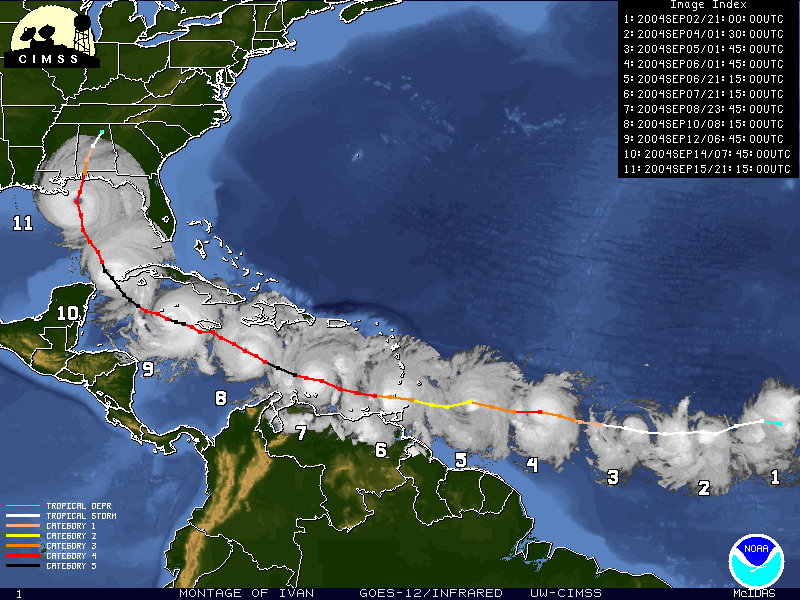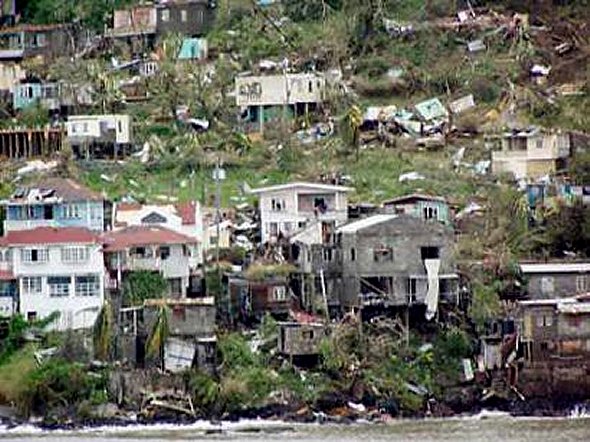Re: Hurricane Ivan 9/15-16 2004
Posted by hanna on 9/15/2012, 4:12 pm
Oh yes in fact my brother in law made fun of me for not liking canes. He said "They are coming to get you." However when he saw "Ivan the Terrible" still out in the Caribbean Sea he changed his tune very, very fast and ordered his wife to make reservations in Pensacola. She on the other hand said "It is to soon give it a few days" smart woman. A tree getting toppled over by the massive power of a category 5 storm in Grand Cayman 2004. http://www.youtube.com/watch?v=Lj7BSCNqZF4 Hurricane Ivan Slams U.S. Gulf Coast Willie Drye for National Geographic News September 16, 2004 Hurricane Ivan, at one point one of the most powerful hurricanes on record, roared into the Gulf Coast near Mobile, Alabama around 2 a.m. CT today. Its peak winds exceeded 125 miles an hour (200 kilometers an hour) and drove a 16-foot (4.9-meter) storm surge. The hurricane had weakened considerably from its top intensity earlier this week. But it still inflicted heavy damage in Pensacola, Florida, about 35 miles (56 kilometers) east of where the storm's eye came ashore. Ivan made landfall as a Category Three on the Saffir-Simpson scale, which rates hurricanes from one to five according to wind speeds and destructive potential. A Category Three hurricane has winds from 111 to 130 miles an hour (179 to 209 kilometers an hour). Although the eye of Hurricane Ivan went ashore west of Pensacola, the city caught the full force of the storm, because it was struck by the storm's front right quadrant. This part of a hurricane always packs the strongest punch: It combines the storm's strongest winds with the force of the hurricane's forward motion. Six people were killed in Bay County, Florida, and officials know that more people have died. Janice Gilley, a county commissioner in Escambia County-which includes Pensacola-said an elderly couple refused to leave their home on Santa Rosa Island, a barrier island just offshore from Pensacola. As of early this morning, the couple's fate was unknown. More Fatalities Gilley said 25-foot (7.6-meter) waves were already pounding Santa Rosa Island Wednesday around 4 p.m., when the bridges leading to the mainland were closed. The elderly couple had not left by then, she said. Fatalities have been reported in Escambia County, but Gilley said it could be days before officials know how many people died. Four hospitals in the city were seriously damaged by the storm, and the roof was torn off a nursing home, she said. No one was killed in those incidents, she said. In Flomaton, Alabama, five people were trapped when their house was destroyed. Rescue workers tried but couldn't get to the people as the storm still raged. Gilley, who lives about 40 miles (64 kilometers) north of Pensacola, said the hurricane's fiercest winds started pounding the area around midnight and continued unabated for "five or six hours." "It sounded like a train, for hours," she said. "Like a train going right above us, for hours." Downtown Pensacola started going underwater around sundown Wednesday. By 7 p.m., the water had reached the city's civic center, where about 2,700 people had taken shelter. The evacuees went to higher levels in the building to escape the water. Gilley said she expected extensive damage in downtown Pensacola, including the city's historic waterfront residential district, which has structures dating back to the early 19th century. The damage in Florida's Panhandle added to the state's hurricane woes during what may become one of the worst hurricane seasons on record. Three major hurricanes have battered Florida since August 13, leaving thousands of Floridians homeless. Millions Brace The U.S. Census Bureau estimated Wednesday that almost 16 million people in six states would feel Ivan's wrath in some form today as Ivan pushed hurricane-force winds 150 miles (240 kilometers) inland and spread torrential rainfall over a much wider area. More than 1,350 cities are likely to see varying degrees of damage from the storm, the Census Bureau said. Emergency management officials in the Gulf Coast states reported that about 2 million people evacuated a 300-mile (480-kilometer) stretch of coastline from Louisiana to the Florida Panhandle. At 7 a.m. today, police and rescue crews were just beginning to assess the damage in Mobile, Alabama. David Coggins, a regional coordinator for the Alabama Emergency Management Agency, said no deaths had been reported there, nor were there any reports of major structural damage. Power was out in some sections of the city, however, and Interstate 65, which runs through Mobile, was impassable because of tree limbs and other debris, he said. "We came through much better than we thought we would," Coggins said. Mississippi's coast also was spared major damage. A.J. Holloway, mayor of Biloxi, said damage in his city had been minimal. "It looks pretty good, all in all, very minor damage that I can see so far," Holloway said this morning. "Some roofs damaged here and there, a few trees down in the streets, nothing major. No major flooding. U.S. 90 is open, and all the piers survived. We're very lucky." River's Flow Reversed The massive hurricane's landfall began the final phase of Ivan's nearly 3,000-mile (4,800-kilometer) rampage across the Caribbean Sea and Gulf of Mexico and into the south central United States. In its wake, the hurricane has left at least 70 dead and inflicted billions of dollars worth of damages in Grenada, Jamaica, the Cayman Islands, Cuba, and the United States. On September 12, while the storm was still in the Caribbean, its winds reached 165 miles an hour (266 kilometers an hour), and its barometric pressure fell to 26.86 inches, or 910 millibars, making it the sixth most powerful hurricane to form in the Atlantic Basin. As Ivan approached the Gulf Coast, a National Oceanic and Atmospheric Administration data buoy anchored about 65 miles (105 kilometers) south of Mobile Bay reported waves more than 32 feet (9.8 meters) high at 9:50 a.m. Wednesday. At that point, the eye of Hurricane Ivan was more than 130 miles (209 kilometers) south of the buoy. As nightfall approached and the storm drew nearer, the same buoy reported waves almost 50 feet (15 meters) high. Ivan altered natural forces all along the Gulf Coast Wednesday. Ivan's eye stayed more than 300 miles (480 kilometers) offshore from Tampa Bay, Florida. But as the eye drew abreast of Tampa, it sent a storm surge into the bay that temporarily reversed the flow of the Hillsborough River and caused some flooding in the city. "It's sure an odd sight seeing the river flow from the bay instead of to the bay," said Alan Snel, a reporter for the Tampa Tribune. As Florida residents dig out from yet another pounding, coastal residents in the Carolinas and Georgia will be keeping an eye on Hurricane Jeanne, which could threaten the Atlantic Coast by the middle of next week. Willie Drye is the author of Storm of the Century: The Labor Day Hurricane of 1935, published by National Geographic. http://news.nationalgeographic.com/news/2004/09/0916_040916_hurricaneivan.html http://www.compasscayman.com/caycompass/2012/09/12/No-let-up-in-hurricane-season-on-Ivan-s-anniversary/  Granada  Grand Cayman  http://www.philipnadeau.com/adventure/hurricane-ivan2004/ivan.html There excellent photos on this site. http://www.2004hurricanes.com/misc-ivan-photos.html |
663
In this thread:
Hurricane Ivan 9/15-16 2004 - pcola52, 9/15/2012, 3:01 pm
- Tell me about it! - Beachlover, 9/16/2012, 3:05 am
- Re: Hurricane Ivan 9/15-16 2004 - Skip Wiley, 9/15/2012, 6:15 pm
- Re: Hurricane Ivan 9/15-16 2004 - hanna, 9/15/2012, 4:12 pm
- Re: Hurricane Ivan 9/15-16 2004 - pcola52, 9/15/2012, 4:28 pm
- Re: Hurricane Ivan 9/15-16 2004 - hanna, 9/15/2012, 5:19 pm
- Re: Hurricane Ivan 9/15-16 2004 - jimw, 9/16/2012, 9:46 am
- Re: Hurricane Ivan 9/15-16 2004 - hanna, 9/15/2012, 5:19 pm
- Re: Hurricane Ivan 9/15-16 2004 - pcola52, 9/15/2012, 4:28 pm
< Return to the front page of the: message board | monthly archive this page is in
Post A Reply
This thread has been archived and can no longer receive replies.